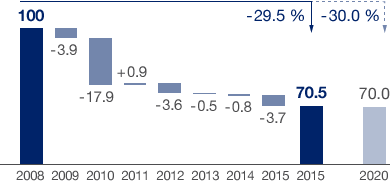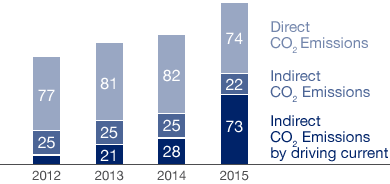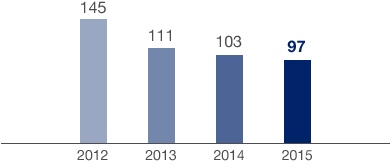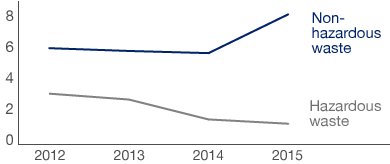Ecology
Emissions and Energy
HHLA has published its carbon footprint regularly since 2008 as part of the international Carbon Disclosure Project (CDP). The CDP is a non-profit initiative which manages one of the world’s largest databases of corporate greenhouse gas emissions on behalf of institutional investors and makes this information available to the public.
HHLA calculates its CO2 emissions on the basis of the Greenhouse Gas Protocol Corporate Standard (revised edition), a global standard for recording greenhouse gas emissions. Within the HHLA Group, air pollution largely consists of CO2 emissions. These are primarily influenced by throughput and transport volumes, traction services provided by the Group’s own locomotives and the use of electricity from renewable sources. In line with the Greenhouse Gas Protocol, electricity procured separately from renewable sources was classified as carbon-neutral. The power needed by a terminal depends largely on the number of seaborne containers it handles and the number of containers transported over land by rail and truck. HHLA uses seaborne and onshore throughput as an effective indicator to determine specific CO2 emissions in line with the recommendations of the European Economics Environment Group (EEEG).
HHLA has set itself the following climate protection target: by 2020, the Group intends to reduce CO2 emissions by at least 30 % for each container which it handles. The 2008 figures serve as the baseline here. In the period from 2008 to 2015, the company already succeeded in reducing CO2 emissions by 29.5 % per container handled. Specific CO2 emissions fell by 5.0 % in the year under review.
Reduction in Specific CO2 Emissions since 2008
Climate protection target: 30 % reduction by 2020

Direct and Indirect in CO2 Emissions
in thousand tonnes

A long-term increase in the percentage of electricity used within the Group’s energy mix will enable the company to utilise more renewable energies and thereby substantially reduce its carbon footprint. HHLA is therefore converting more and more of its equipment and machinery at the terminals to electricity. Such equipment and machinery produces fewer emissions and less noise and is also easier to service. The electricity required by all office buildings and workshops in Hamburg occupied by HHLA, the Container Terminal Altenwerder (CTA) and the all-electric yard crane system at the Container Terminal Burchardkai (CTB) comes from renewables. In the reporting period, these measures reduced CO2 emissions by 24,108 tonnes (previous year: 26,645 tonnes). A photovoltaic system at the Container Terminal Tollerort (CTT) installed and operated by the energy supplier Hamburg Energie Solar produced 119,450 kWh of CO2-free electricity in the year under review.
In addition to the active expansion of renewable energies, HHLA particularly promotes the use of energy-efficient and low-emission machinery and equipment. In the year under review, the company maintained a fleet of 64 all-electric cars. Due to the positive experience the company has had with these all-electric cars, 24 leases were extended by another three years for the oldest vehicles and a half-dozen new electric vehicles have been ordered that will be delivered over the course of 2016. HHLA’s electric vehicles are powered by renewable electricity and are a quiet, low-maintenance solution which does not generate any local emissions. The electric vehicles cover a distance of some 475,000 km each year and thus reduce CO2 emissions by approximately 148 tonnes. Two new straddle carriers that comply with strict requirements of the European Union’s emissions standard Euro 4 went into operation at the CTB in the reporting year. With their extremely low emissions, these modern vehicles make an important contribution towards reducing pollution at the container terminal. In addition, the computer-aided optimisation of container storage positions minimises the distance travelled by transport equipment, thereby reducing energy consumption and noise pollution. The use of retreaded tyres for various container handling machines also helps to improve the company’s use of resources.
|
2012 |
2013 |
2014 |
2015 |
||||||||
|
||||||||||||
Diesel and heating oil in million of litres |
26.6 |
26.8 |
28.5 |
25.7 |
||||||||
Petrol in million of litres |
0.1 |
0.1 |
0.1 |
0.1 |
||||||||
Natural gas in million of m3 |
2.1 |
3.1 |
1.8 |
2.3 |
||||||||
Electricity1 in millions of kWh |
139.9 |
148.7 |
154.4 |
138.3 |
||||||||
thereof from renewable energies |
70.2 |
78.2 |
84.0 |
76.0 |
||||||||
Traction current in millions of kWh |
16.9 |
37.9 |
51.7 |
130.3 |
||||||||
District heating in millions of kWh |
4.6 |
4.6 |
3.7 |
3.2 |
||||||||
Several projects were also continued in the field of energy-efficient lighting. 24 additional yard cranes were switched to needs-based LED lighting at CTA. 40 of 52 yard cranes now use needs-based LED lighting at the CTA. As well as reducing lighting emissions, this system cuts electricity consumption by some 90 %.
The introduction of a DIN ISO 50001 certified energy management system has now been successfully completed by Hamburger Hafen und Logistik AG and HHLA Personal Service GmbH.
Water Consumption
Developments in Water Consumption
in dam3

HHLA locations in Germany, Poland, the Czech Republic, Slovakia and Ukraine.
Water is mostly used in the HHLA Group to clean large-scale equipment and containers, as well as for employee hygiene. Compared to the previous year, the amount of water consumed by operations in Germany, Poland, Slovakia, the Czech Republic and Ukraine fell by a further 5.2 % to 97,305 m3 in 2015 (previous year: 102,664 m3). The water treatment plant at CTB, which was in operation for the full year for the first time, contributed towards this positive trend. HHLA’s facilities in Hamburg draw water from the public supply network.
Waste and Recycling
Developments in the Volume of Waste
in thousand tonnes

HHLA reduces refuse and separates rubbish for recycling wherever possible so that reusable waste can be fed back into the resource cycle. Excluding soil and building rubble, the amount of waste produced at the sites in Germany increased year-on-year by 28.8 % to 9,544 tonnes in 2015 (previous year: 7,408 tonnes). This is due to a considerable rise in the amount of waste not fit for consumption or further processing, such as bananas, pineapples and potatoes. HHLA has no influence on the amount of such waste, as it includes goods that were already unsuitable when they reached Hamburg. Without these amounts, the volume of waste at HHLA fell by 2.3 % in the reporting period. There was an even stronger decline in hazardous waste: this figure fell substantially by 17.2 % to 1,332 tonnes (previous year: 1,609 tonnes). This figure represents a decrease of almost 60 % compared to 2010.
This very positive development was mainly attributable to the construction of a water treatment plant at CTB which was operational for a full year for the first time this year. The water used to clean large machinery is treated at this plant before being reintroduced into the cleaning cycle. The process therefore helps to conserve resources in two ways: as well as substantially reducing fresh water use, it decreases the volume of waste classified as hazardous. This also has a positive effect on the amount of sludge from oil/water separators collected at the washing, fuelling and parking spaces for straddle carriers and AGVs. The volume of waste in this category fell strongly by 44.7 % year on year, taking it to 470 tonnes (previous year: 850 tonnes). The remaining mixture of sludge, oil and water is processed at a chemical water treatment plant operated by a specialist disposal company. Once it has been separated from the oil, the water passes through a biological waste water treatment plant. The quantity of overripe bananas and other foodstuffs unsuitable for processing or consumption accounted for the largest proportion of waste. It more than tripled year on year to 3,343 tonnes (previous year: 1,091 tonnes). A large proportion of this was recycled to generate biogas. Approximately 300,000 kWh of electricity was generated without CO2 in this way in 2015; twice as much as in 2014. 1.8 % less commercial waste was generated in the reporting period. At 1,828 tonnes, this type of refuse represented the second-largest waste volume (previous year: 1,862 tonnes). Scrap metal, which was up 11.1 % against the previous year at 1,1,39 tonnes (previous year: 1,025 tonnes) was fed completely into the recycling system. Paper and cardboard packaging accounted for 609 tonnes of total waste (previous year: 580 tonnes) while scrap wood and building timber made up 403 tonnes (previous year: 578 tonnes).
HHLA strives to conserve resources at its terminals, e.g. by using a total of 58,300 tonnes (previous year: 40,300 tonnes) of recycled building materials to maintain its terminal areas during 2015. Of this amount, waste incineration slag accounted for the largest share (40,000 tonnes). The amount of material used from asphalt recycling amounted to 15,800 tonnes in the year under review. A further 2,500 tonnes was electric furnace slag, which results from the melting of steel scrap and mineral additives in electric arc furnaces and is now reused as aggregate at the terminals. The use of this recycled building material means that less natural stone needs to be mined, thus protecting the landscape.
In maritime logistics, a terminal is a facility where freight transported by various modes of transport is handled.
A long-legged vehicle used to transport containers at the terminals. The driver manoeuvres their straddle carrier into position above a container and lifts it up. The vehicles can stack containers up to four high.
Fully automatic, driverless transport vehicle that carries containers back and forth between the container gantry cranes on the quayside and the block storage yard at the HHLA Container Terminal Altenwerder.